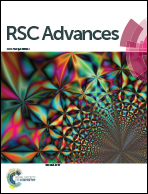Fabrication of a reversible thermochromism based temperature sensor using an organic–inorganic composite system
Abstract
Temperature is considered a crucial physical parameter for several applications ranging from our day to day life to industrial applications. Studies have been reported to monitor the temperature by using various methods. Here, the present study demonstrates the fabrication of a simple and inexpensive temperature sensor based on the phenomenon of thermochromism, that is, the temperature can be monitored by the visual change in the sensor's color without using any additional circuitry. The mechanism of color change is associated with the difference in the coordination number of the complex compound due to the loss of crystal water in the organic–inorganic composite system. The screen printing process has been used to fabricate thin films of varying compositions in order to optimize the thermochromism in the temperature range of interest. Moreover, the reversibility of the color with a decrease in temperature allows the reusability and longevity of the sensor thus developed.



 Please wait while we load your content...
Please wait while we load your content...